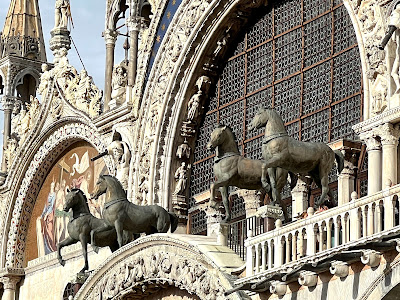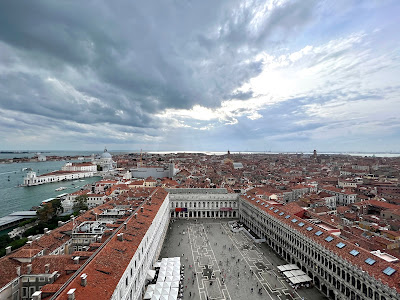The World's Most Romantic City
Capital of a 1000 Year Maritime Empire
I first visited Venice in 1974. I was 17 and the trip was my introduction to Europe. I financed the trip through three years working till 2:30 am at minimum wage as a parking lot attendant (babysitting some pretty famous drunks) in Oakland's Jack London Square.
Our month long student tour crisscrossed Europe and was patiently chaperoned annually by Pege Rankin (Skyline High School's formidable journalism teacher). One of our most memorable stops was Venice.
The 1974 trip in retrospect came at strategic time the history of Italy. The nation still displayed the residual signs of the economic damage inflicted during WWII. It's status was reflected by its very currency, the fragile Lira. In 1974 Italy couldn't even afford to mint enough coins for circulation. So merchants gave change in telephone tokens, apples, Zots candy, and/or whatever seemed appropriately fungible. Vaporetto cashiers routinely short changed tourists and even basic things like safe tap water could not be taken for granted.
In fact it was in Venice that I learned (the hard way) what happens when tap water is not potable. After a big snifter of delicious lemonade I was immediately beset with a gastrointestinal emergency requiring my desperate race back to the convent we were staying in.
Upon arrival the stern sister guarding the convent door was clearly not initially convinced by the urgency of my delicate predicament.
A half century, and many return trips later, I find Venice still to be performing a high wire act balancing beauty with fragility. But its tap water is now safe to drink.
The fact that Venice stands at all is nothing short of a miracle. Human habitation in the lagoon dates back to the 10th century BC. The Commune of Venice of today consists of 118 small islands in a tidal lagoon at the top of the Adriatic bound together by more than 400 bridges.
Venice, as a sovereign global power, reached its zenith more than 600 years ago. During the middle ages and Renaissance it was one of the world's most important financial and maritime powers and its global influence on architecture and art last to this day.
However, Venice's sovereign status was ended by Napoleon in 1797. In 1866 Venice joined the Kingdom of Italy.
Yet against formidable odds Venice endures.
It's foundations endure the relentless pummeling delivered by the massive ships and watercraft that bring it economic life.
It's buildings endure subsidence as they slowly settle into the silt of a lagoon that endures the increasing Acqua Alta (severe tides) brought on by global warming.
And, each year, it endures 20-30 million visitors eager to experience its history and magic.
Many visitors seem to arrive oblivious to the fact that it is home to 51,000 permanent residents who struggle to preserve its legacy while watching precious housing stock get monetized into short term rentals.
As I'm averse to crowds, I now limit visits to the off season. Why go in the summer when it is hot, humid, and overcrowded?
That is just plain nuts.
In fact, one of my most memorable visits was in mid-winter. On that trip, while all bundled up, we found a Venice that was almost eerily quiet and peaceful. It's misty lagoons were filled with tightly covered gondolas rocking gently patiently waiting for spring.
Yet I always return.
Perhaps because there is nowhere on earth like Venice. At every turn I find so much to discover. Just a random dip into any little church can deliver artworks by Titian, Tiepolo, Tintoretto, or Veronese. Venetian Campo's are filled with music, the joys of everyday life, and young couples arriving to be married in this most romantic of cities.
Isola di San Giorgio Maggiore
(Viewed from the Top of the Campanile of Saint Mark)*
Evening Traffic in Calm Venetian Canals*
Pizza San Marco
(Viewed from San Giorgio Maggiore)*
The original Campanile was begun in the 900's and was altered continuously. It finally reached its full height in 1514. It's top was redesigned numerous times and bells were added incrementally. The Campanile served as part of a fortification system built to provide views and signal advance warning of approaching adversaries.
In 1902, however, without warning the entire original Campanile crumbled to the Piazza. So the Campanile seen today is actually a replica completed in 1912.
The Triumphal Quadriga*
The majestic "bronze" horses that adorn Saint Marks are also replicas of the originals and both the originals (moved into the basilica for preservation purposes) and the replicas are actually almost pure copper.
The original horses likely date back to the second or third century. They were looted from Constantinople in 1204. The looters had to removed the heads of the horses to transport them. Collars were added to conceal the marks made to cut the heads. When Napoleon arrived in 1797 he felt obliged to steal them again. They were returned to Venice in 1815.
Piazza San Marco
(From the Campanile)*
Probably the most photographed site in Venice is Piazza San Marco. It is the historic center of Venetian culture, religion, commerce, and governance. It is home to the Doge's Palace, the Bridge of Sighs, and is Venice's only Piazza. All other open spaces in Venice are smaller and referred to as Campo (fields).
Gondola Fèrro*
(the six pointed counterbalance blade found on every gondola)
After an all too short visit, it was time to join cycling buddies at Marco Polo Airport to board a shuttle up the mountains to Cortina d'Ampezzo to begin a few days of cycling in the Dolomites (or Dolomiti to the Italians).
Part 4: Cycling the Dolomites to follow.
Roadboy's Travels © 2023
* Many thanks to Steven Bay for photographs noted above.








No comments:
Post a Comment